
The Neva is a river in northwestern Russia flowing from Lake Ladoga through the western part of Leningrad Oblast to the Neva Bay of the Gulf of Finland. Despite its modest length of 74 kilometres (46 mi), it is the fourth-largest river in Europe in terms of average discharge.
The Fontanka, a left branch of the river Neva, flows through the whole of Central Saint Petersburg, Russia – from the Summer Garden to Gutuyevsky Island. It is 6.7 kilometres (4.2 mi) long, with a width up to 70 metres (230 ft), and a depth up to 3.5 metres (11 ft). The Moyka River forms a right-bank branch of the Fontanka. Lined along the Fontanka Embankment stand the former private residences of Russian nobility.

Nevsky Prospect is a main street located in the federal city of St. Petersburg in Russia. Its name comes from the Alexander Nevsky Lavra, the monastery which stands at the eastern end of the street, and which commemorates the Russian hero Prince Saint Alexander Nevsky (1221–1263). Following his founding of Saint Petersburg in 1703, Tsar Peter I planned the course of the street as the beginning of the road to Novgorod and Moscow. The avenue runs from the Admiralty in the west to the Moscow Railway Station and, after veering slightly southwards at Vosstaniya Square, to the Alexander Nevsky Lavra.
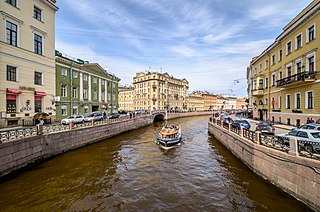
The Moyka is a short river in Saint Petersburg which splits from the Neva River. Along with the Neva, the Fontanka river, and canals including the Griboyedov and Kryukov, the Moyka encircles the central portion of the city, effectively making that area an island or a group of islands. The river derives its name from the Ingrian word Muya for "slush" or "mire", having its original source in former swamp. It is 5 kilometres (3 mi) long and 40 metres (130 ft) wide.
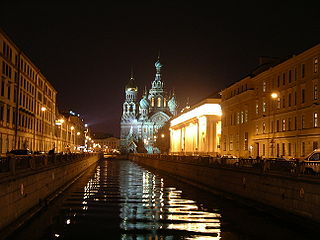
The Griboyedov Canal or Kanal Griboyedova is a canal in Saint Petersburg, constructed in 1739 along the existing Krivusha river. In 1764–90, the canal was deepened and the banks were reinforced and covered with granite.

Sadovaya Street or Garden Street is a major thoroughfare in Saint Petersburg, Russia, passing through the historic city center.
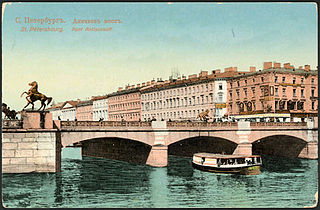
The Anichkov Bridge is the oldest and most famous bridge across the Fontanka River in Saint Petersburg, Russia. The current bridge, built in 1841-42 and reconstructed in 1906-08, combines a simple form with some spectacular decorations. As well as its four famous horse sculptures (1849–50), the bridge has some of the most celebrated ornate iron railings in Saint Petersburg. The structure is mentioned in the works of Pushkin, Gogol, and Dostoevsky.
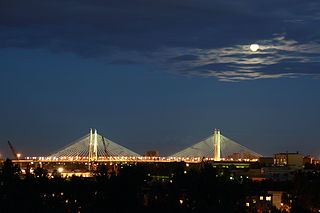
The Great Obukhovo Bridge is the newest bridge across the Neva River in Saint Petersburg, Russia. It is the only bridge across the Neva which is not a drawbridge. One of the longest bridges in Russia, it is the first fixed bridge and largest bridge across the Neva. Of course it is the largest bridge in St. Petersburg by the size of the covered span. It is located in Nevsky District, in the middle stream of the Neva. It connects Obukhovskaya Oborony Avenue with the Oktyabrskaya embankment. It is a cable-stayed bridge; the steel wire ropes are the key element of the supporting construction. But what looks like a bridge is actually two identical twin bridges with opposite directions of movement along them. One is located upstream of the Neva (southern) and is for driving eastward, the other downstream (north) is for driving in a western direction.

The Volodarsky Bridge is a moveable bridge across the Neva River in Saint Petersburg, Russia. The bridge connects Narodnaya and Ivanovskaya streets. It is named after V. Volodarsky, a revolutionary, who was killed near the future bridge in 1918. It is the only bridge in the city with an overpass for trams. The bridge is part of the Central Arc Thoroughfare. In 1932-1936, according to engineer G.P. Peredery's project, a three-span reinforced concrete arch bridge with a metal double-winged drawbridge was built. In 1986-1993, the old bridge was dismantled and replaced with a metal girder. The bridge length is 332 meters, the width is 24–27 meters. Upstream is the Bolshoy Obukhovsky Bridge, and below is the Finland Railway Bridge.
The appearance of Saint Petersburg includes long, straight boulevards, vast spaces, gardens and parks, decorative wrought-iron fences, monuments and decorative sculptures. The Neva River itself, together with its many canals and their granite embankments and bridges help to give the city its particular ambience.

The Potseluev Bridge is a bridge across the Moyka River in Saint Petersburg, Russia. The name of the bridge spurred numerous urban legends. The panoramic view of Saint Isaac's Cathedral that opens from the bridge makes it a popular subject of artists paintings.
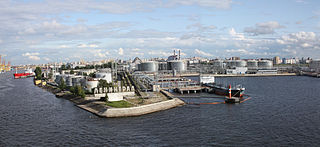
The Great Port of St. Petersburg or Port of St. Petersburg is a major seaport serving the city of St. Petersburg in northwest Russia. The port's water area is 164.6 km2. The mooring line is 31 km long and the water is 25 metres (82 ft) deep at the port's deepest anchorages. Since 2011, the port has been under the authority of a state-owned enterprise, the Port Authority of the Great Port of St. Petersburg. This agency oversees commercial navigation in the seaport of St. Petersburg and beyond in the designated areas of responsibility of the Russian Federation.

Saint Petersburg – second-largest city in Russia. An important Russian port on the Baltic Sea, it has the status of a federal subject. Its name was changed to "Petrograd" in 1914, then to "Leningrad" in 1924, and back to Saint Petersburg in 1991.
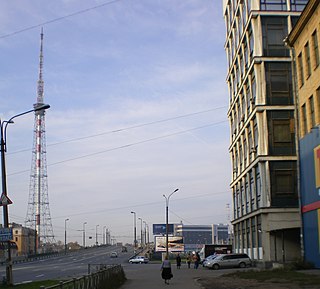
Kantemirovskiy Bridge is a large modern drawbridge in Saint Petersburg, Russia across the Bolshaya Nevka arm of the Neva river. The bridge connects the northern Aptekarsky Island of the north-central Petrogradsky District on Petrograd Side with northeastern Vyborgskiy District of the city and over it with the northeast and east of Saint Petersburg. It receives automobile traffic from Bolshoy Prospekt via Prospekt Medikov in the southwest and takes it to Kantemirovskaya Street on the right-hand riverside, after which it was named. The street itself was named in 1952 after the railway station of a settlement of Kantemirovka in Voronezh region which was liberated from Nazi Germany troops by the Soviet Red Army in December 1942. The settlement in its turn was named after its 18 century owner Dimitrie Cantemir and his brother Constantin, Moldavian princes given shelter in Russia after a military defeat and entered into Russian nobility.

Staro-Kalinkin Bridge is a bridge across the Fontanka River in Admiralteysky District, Saint Petersburg. It connects Kolomensky and Bezymyany Islands. Along with Lomonosov Bridge it is one of 7 stone three-span bridges across the Fontanka built in the 1780s, which have survived to this day.

Smezhny Bridge is a bridge across the Kryukov Canal in the Admiralteysky District of Saint Petersburg that connects the Spassky and Pokrovsky Islands.

Kryukov Canal is one of the canals in central Saint Petersburg, Russia.

Staro-Nikolsky Bridge spans the Kryukov Canal in the Admiralteysky District of Saint Petersburg, Russia. It connects the Spassky and Pokrovsky Islands. It is a monument of history and culture.



























